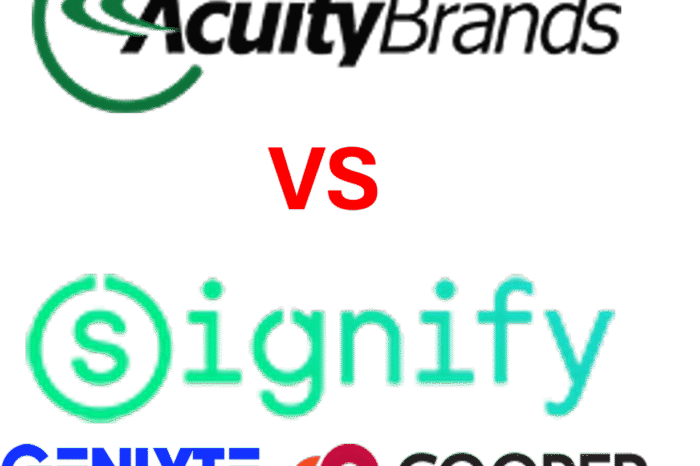Lighting Changes at Key Manufacturers … And 2018 Outlook
 As the year comes to an end this month has brought changes to a number of key manufacturers which may stem from a common factor. Additionally, 2018 product and lighting sales performance outlooks are being shared that we thought may be of interest (and in some cases we’ve added our thoughts).
As the year comes to an end this month has brought changes to a number of key manufacturers which may stem from a common factor. Additionally, 2018 product and lighting sales performance outlooks are being shared that we thought may be of interest (and in some cases we’ve added our thoughts).
The Changes
The changes have occurred at Cree, Philips Lighting, LedVance and TCP. They include:
- Cree – Daniel Castillo (President) and Keith Eagle (SVP Commercial Lighting Sales) reportedly left the company (the Triangle Business Journal used the words “were cut”). Both are experienced lighting veterans. It’s interesting that they leave during the evaluation process that new CEO Greg Lowe is undertaking within the company. Cree has had challenges meeting numbers, launching products and positioning its new “value line” (C-Lite). Lighting was the only division that didn’t meet its Q3 forecast. Lowe has stated that he’ll announce future strategic direction after his review, but:
- The company makes money on “technical” products (its Wolfspeed group and its LED chips).
- Lighting has had its challenges and some may recall that the company got into the lighting business because it was challenged in getting OEMs to convert to LEDs. Cree’s original lighting business was called LLF and was designed to disrupt. LLF was originally incubated inside Cree, spun-out and then acquired and rebranded Cree Lighting.
- While many state that Cree is a product innovator (from a chip / driver) viewpoint in the high power arena, it doesn’t appear that much of the market is willing to pay a premium for innovative / high quality products. This may mean higher than necessary R&D costs (people) and product design that contractors don’t support in selling to their customers? They could be successful at the specifier level but can they effectively penetrate the retrofit / renovation market?
- Depending upon the speed of replacement, and the “whom” as either lighting or ED experience is needed, could shed insights into the future of the division.
- Philips Lighting – Edison Report reported that Amy Huntington announced her resignation as President, Philips Lighting Americas, from the company effective December 31. Reportedly she is going back to Chicago and out of the lighting industry.
- LedVance – They replaced their Wilmington, MA based CEO, Jes Munk Hansen, and are replacing him with an individual who will be based in Garching, Germany. From our experience, when senior management is based outside of a major market and hasn’t announced someone responsible for the market, there isn’t much of a tendency to be “responsive to the market” and, as many know, the US electrical distribution / retail / lighting market is different and more nuanced than many other regions.
- TCP – The company that Ellis Yan privately owned and then took public (which he was then removed from) is now back in the private hands of Mr. Yan and his brother. Whether this will signal a change in direction is unknown at this time.
- And interesting that Kaj Den Daas, who was with Philips and TCP, said in this interview with Edison Report, that he founded Quality Lighting Source with Ellis Yan, to go to market in Japan and the US. The company is focused on lamps, has some fixtures and reportedly its value proposition is “price”.
Possible common factor? The continued decline and commoditization of the LED market. In the case of Cree and Philips they are fixture companies that try to focus on technology, innovation, product specification and are getting undercut on pricing regularly and hence are continuously trying to reinvent themselves in a quick moving market. In the case of LedVance and TCP, more lamp-oriented companies who have also suffered from price deflation, product commoditization and a quick moving market. With 3 of the 4 being publicly held companies, is it feasible to meet shareholder expectations?
On the Market
As part of the changes and looking into 2018, consider:
- GE Lighting – Who will buy it? Who may even be interested and what is the strategic value of the business to someone? Is it the name (and for how long presuming GE is willing to license the name)? Is it access to distribution and / or retail space? From talking with others in the equity / M&A markets, they presume an Asian company but wonder why it’s taking so long and if the business is too small?
- Current by GE – Another GE division for sale. Could GE bundle it with GE Lighting? Could the company go to a PE firm who tries to make acquisitions to further develop a “digital energy” company? Does it get broken up? Perhaps a Johnson Control? Verizon? Google?
- Cree Lighting – Based upon the above noted changes regarding Cree, could they be on the block soon? If so, to whom? Is there value in licensing the name? Licensing the patents? Perhaps buying Current and then buying Cree to combine them?
2018 Outlook
Lux Review shared it’s Top 10 Lighting Trends for 2018. The headlines are listed below:
- Luminaires will boast more functionality
Due to increased commoditization and falling prices, light fittings simply won’t just illuminate any more. They’ll have on-board capabilities such as increased intelligence, sensors, build-in wireless connectivity and color tuning. Expect buzzwords such as ‘IoT ready’ and ‘digital light’. (Companies trying to differentiate but there is extensive commoditization at the lower end of the market. Brand manufacturers are investing, the challenge is that this impacts new construction and large retrofit projects. Small to mid-size projects focus more on price. To gain adoption of the functionality, manufacturers need to invest in supporting the channel with brand marketing, concept / application marketing, complex application selling techniques and “sales guides”, otherwise R&D money is invested without an appropriate return.) - Controls will leave the cupboard
Traditionally, lighting controls have resided in a big black box of electronics which sat in a cupboard. In 2018, expect to see the intelligence move into the luminaire. The interface will increasingly be standard devices using Bluetooth. The ‘self-learning’ algorithms popular on consumer thermostats will also begin to appear as standard on lighting control platforms. (Lots of this going on but with little adoption except marquee projects. Some distributors are having some success. The train may be at the gate but it isn’t out of the yard yet.) - Emergency lighting standards will be driven up (this is UK oriented and may not be applicable in the US)
- Li-Fi will begin to get adopted (and we’re having challenges getting controls sold! Perhaps Li-Fi could herald the entrance of tech / communications companies coming into the lighting market? Who knows more about “communications”?)
- Lighting will join the connected office
The so-called ‘connected office’ will start to become a reality in 2018, driven by the big property developers. Companies such as Land Securities and CBRE – under pressure to be seen to be innovating in the sector – already have extensive trials of IoT lighting and will be the ones to create compelling use cases for their clients. The big drivers will be well-being and productivity. (Selling “one-offs” through “use case marketing” will result in slow adoption and high cost of sales. Will lighting agents invest the time for today’s commissions? Supply agents who have lighting lines? Or will manufacturers invest in people and take business direct or hire sales engineers? With over 50% of industry revenue purchased by contractors, who will train them to “sell”?) - Bluetooth will win the protocol war
After two years of internal wrangling, Bluetooth chiefs have ratified a standard which meshes together its beacons, allowing them to give instructions to each other. The move boosts Bluetooth’s reach far beyond the typical 10m range that’s familiar to consumers. In 2018 expect this development to drive IoT lighting into retail, warehouse, commercial offices, and other locations. (Maybe. Don’t know. We’ve co-authored an upcoming article on the various protocols with David Shiller of Lighting Solutions Development which will appear in an upcoming Electrical Wholesaling article. Distributors, if you’d like an advance copy to help with your 2018 lighting planning, email me.) - Human-centric lighting will get serious
- Lighting pollution will be a major issue
- The WELL Building standard will be big
- The industry will be driven by consolidation and partnerships
Stand-alone lighting manufacturers will look increasingly isolated in 2018 as consolidation really takes hold in the market. Expect to see lots of acquisitions and mergers as the fragmented industry tidies itself up. But the really big trend will be partnerships – such as the Philips and Cisco tie-up – where lighting makers buddy up with tech specialists. (It will be interesting to see if there will be consolidation given the multitude of lighting companies in the industry and that many are sourcing their products. Along with consolidation, you may see some decide to close as their ambitions exceed their ability to generate margins to pay operating costs.)
Some other “thoughts” for 2018 outlook:
- Top 5/6 manufacturers (name companies) will continue to increase sales but will also continue to lose market share as they miss the lower-end of the market which goes to more nimble, more cost-effective companies who have products that perform comparably (or at least sufficiently) and contractors and distributors value-engineer projects to compete for customer budgets.
- Contractors, who focus on lighting, become more comfortable with sourcing “direct”. Had two conversations last week with contractors who buy direct when can (container loads) to save and, in one case, explicitly said he is buying from same factories as manufacturers are. This begs the question of “what is the value of the manufacturer brand?” and, as a distributor, “what is your value”? as well as the need for distributors to conduct product gap analyses and manage their salespeople and accounts.
- The lighting market is much bigger than the lighting market through distribution. Product is flowing through many channels and distributors need to consider if they are content with what they have and from whom or if they want to grow this business? In 2018 we’ll see more distributors being open to alternative business models.
- Think eCommerce for what we used to consider the “stock & flow” aspect of lighting. Contractors and others are open to the channel based upon early results to our State of eCommerce End-user / Contractor Perspective survey which will come out next month.
And lastly, a Baird analyst projects lighting will increase only 3% next year. The major lighting companies have said “single digits”. All of the “unfamiliar” brands we’ve talked to are talking double digits. Don’t know who the analyst talks to or how he calculates … maybe only considering new construction?
Hope this gives you something to noodle over the holidays!
Looking for strategies to help accelerate growth? Willing to think outside the box? Need  to sharpen your value proposition, communicate your message within your marketplace and brand yourself as the “go to” resource? Give us a call, this is what we do.
to sharpen your value proposition, communicate your message within your marketplace and brand yourself as the “go to” resource? Give us a call, this is what we do.






















